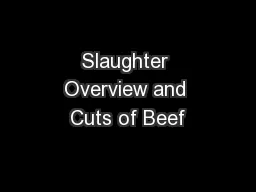

Carcasses Lamb carcasses are usually sent to the cooler whole as they are much smaller Hog carcasses are split into sides by cutting down the backbone Beef and hog carcasses that have been skinned are covered in a heavy cloth soaked in salt water ID: 611852
Download Presentation The PPT/PDF document "Slaughter Overview and Cuts of Beef" is the property of its rightful owner. Permission is granted to download and print the materials on this web site for personal, non-commercial use only, and to display it on your personal computer provided you do not modify the materials and that you retain all copyright notices contained in the materials. By downloading content from our website, you accept the terms of this agreement.
Slide1
Slaughter Overview and Cuts of BeefSlide2
Carcasses
Lamb carcasses are usually sent to the cooler whole as they are much smaller
Hog carcasses are split into sides by cutting down the backbone.Beef and hog carcasses that have been skinned are covered in a heavy cloth soaked in salt water
Called a shroudSlide3
Carcasses
Cooled for 30 or more hours before cutting into wholesale cuts
May also be aged in the cooler for as much as a weekMuscles lock into place and carcass becomes stiffSlide4
Aging
Carcasses undergo a period of aging to allow enzymes and micro organisms to begin the process of breaking down the tissue
Improves tenderness and flavorSlide5
Grading
Carcasses are graded according to USDA standards
Federal meat grading was established in 1925Administered by the AMS (Agricultural Marketing Service) of the USDACertifies class, quality and condition with uniform standards
Grades are determined by the age of the animal and amount of fat intermingled with the muscleSlide6
Quality Grades
Prediction of the eating quality (palatability) of the meat when properly prepared
Prime – has highest degree of fat in the muscleChoice – what most grocery stores supplySelect
Standard Slide7
Yield Grades
Indicate expected yield of edible meat from a carcass and the subsequent wholesale cuts from that carcass
Estimate of the percentage of boneless, closely trimmed retail cuts that come from the major lean primal cutsGraded on a scale of 1-5Slide8
Yield Grades
1 over 52.3 % edible meat2 50 - 52.3% edible meat
3 47.7-50.0% edible meat4 45.4-47.7% edible meat5 less than 45.4% edible meatSlide9
Background
Tenderness or toughness depends on how much the cow used the muscle.
Meat near the shoulder or leg, which is used a lot, is going to be tougher. Cuts in the center (the rib, plate, and loin) are going to be more tender.
Each cut needs to be cooked differently to get the best flavor and most tenderness.Slide10
Beef - Chuck
Contains a great deal of connective tissue, including collagen.
Collagen melts during cooking, making the meat intensely flavorful
Cuts from this area benefit from slow, wet cooking methods like stewing, braising or pot-roasting.
Blade Roast
— an inexpensive cut which lies next to the ribs; more tender than most chuck; makes an excellent roast.
Chuck Steak
— a good choice for kabobs if well marinatedSlide11
Beef - Rib
Rib Roast
— known as a standing rib roast (bone left in), or without the bone for convenient slicing. Excellent when dry roasted.
Rib Steak
— also cut from the rib section, these tender steaks can be purchased bone-in or as boneless rib-eyeSlide12
Beef – Short Loin
This area boasts extremely tender cuts and can be prepared without the aid of moist heat or long cooking times.
Porterhouse Steak
— a very popular steak cut from the rear end of the short loin. The porterhouse consists of both tenderloin and sirloin tip. The tenderloin is often served separately as filet mignon
T-bone Steak
— cut from the middle section of the short loin; similar to the porterhouse steak; has a smaller piece of the tenderloin.
Tenderloin
— often considered the most tender cut of beef; responds well to sauces, meaning the meat does not overpower the flavor of the sauce. It can be cut as the whole strip, or into individual steaks for filet mignon.Slide13
Wrap it Up!
http://www.youtube.com/watch?v=dGqw2gu1zX8